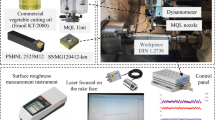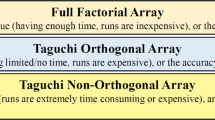Abstract
The manufacturing industry solves mainly a double problem of high productivity rate and quality of product. This dual task depends on the machining regimes which changes have limitations conditioned by the quality of products machined and the reliability of the machine tool units. Studies of machining processes show the productivity rate of machine tools depends on the cutting speed and reliability of the cutting tools. An increase in the cutting speed decreases the tool life and machining time. The optimal balance of the cutting speed and tool life yields the maximal productivity rate of the machine tool. Recommended machining regimens for cutting tools’ obtained at laboratory conditions do not consider the specificity of work of machine tool units in the manufacturing environment. The publications related to the optimization of machining processes do not consider the specificity of muti-blade cutting tools' work and the reliability of machine tool units. The milling machining processes implement the multi-cutter tool, in which cutters are involved serially. The specificity of the milling tool operation is not fully described in publications. The presented research paper considers a mathematical model for optimal cutting speed by the criterion of the maximal productivity rate for the face milling process.



Similar content being viewed by others
Data availability
The authors declare that the data supporting the findings of this study are available within the article.
Abbreviations
- c :
-
Distance for the implementation of machining processes with quality
- b :
-
Empirical constants that depend on the cutter tool material
- C :
-
Empirical constants resulting from regression analysis of the tool life
- d :
-
Depth of cut
- D :
-
Diameter of the face milling tool
- F :
-
Feed rate of the face milling tool
- f p :
-
Feed rate per cuter of the face milling tool
- k :
-
Number of milling toll revolutions for the milling process
- L :
-
Length of the workpiece
- m r :
-
Meantime the change of the milling tool
- n :
-
Rotating speed of the milling tool
- p :
-
Number of cutters (blades) of the face milling tool
- Q :
-
Productivity rate of the machine tool
- r m :
-
Number of changes in the milling tool
- T :
-
Tool life of the face milling tool
- t a :
-
Auxiliary time for the load and unload of the workpiece, the fast motions of the machine units to the workpiece and back, etc.
- t m :
-
Machining time
- V :
-
Cutting speed
- \(\sum {\lambda_{i} }\) :
-
Failure rates for machine tool units
References
Kalpakjian S, Schmid SR (2009) Manufacturing engineering & technology, 6th edn. Prentice-Hall
Rao RV (2011) Advanced modeling and optimization of manufacturing processes, 1st edn. Springer, London
Ashby F, Esawl A (1999) Cost estimating for process selection. In: Proc ASME Design for Manufacturing Conference, Las Vegas, Nevada
Usubamatov R (2018) Productivity theory for industrial engineering. Taylor & Francis, London, New York, Boca Raton
Mukherjee I, Ray PK (2006) A review of optimization techniques in metal cutting processes. Comput Ind Eng 50(1):15–34. https://doi.org/10.1016/j.cie.2005.10.001
Zhao JB (2013) Research on the NC machine fault diagnosis and repair system with case-based reasoning. Appl Mech Mater 401–403:1243–1246. https://doi.org/10.4028/www.scientific.net/AMM.401-403.1243
Shaft MC (2005) Metal cutting principles, 2nd edn. Oxford University Press, New York, pp 295–297
Kolahan F, Manoochehri M, Hosseini A (2011) Simultaneous optimization of machining parameters and tool geometry specifications in turning operation of AISI1045 steel. World Academy of Science, Engineering, and Technology, pp 786–789. https://doi.org/10.5281/zenodo.1080121
Balogun VA, Edem IF, Gu H, Mativenga PT (2018) Energy centric selection of machining conditions for minimum cost. Energy 164:655–663
Bouzakis KD, Paraskevopoulou R, Giannopoulos G (2008) Multi-objective optimization of cutting conditions in milling, using genetic algorithms. In: Proceedings of the 3rd International Conference on Manufacturing Engineering, Greece, pp 763–773
Kountanya RK, Boppana P (2008) Optimization of machining of automotive components with polycrystalline cubic boron nitride. IMechE, Part B 222(7):797–805
Deb K, Datta R (2011) Hybrid evolutionary multi-objective optimization of machining parameters. Indian Institute of Technology Kanpur, KanGAL Report Number 2011005, p 23
Yang CL (2011) Optimizing the glass fiber cutting process using the Taguchi methods and grey relational analysis. New J Glass Ceram 1(1):13–19 (ISSN: 2161-7554)
SoleymaniYazdi MR, Khorram A (2010) Modeling and optimization of milling process by using RSM and ANN methods. IACSIT Int J Eng Technol 2(5):474–480 (ISSN: 1793-8236)
Saffar RJ, Razfar MR, Salimi AH, Khani MM (2009) Optimization of machining parameters to minimize tool deflection in the end milling operation using genetic algorithm. World Appl Sci J 6(1):64–69
Polyanin A, Manzhirv A (2007) Handbook of mathematics for engineers and scientists. Chaman & Hall/CRC, Taylor & Francis, Boca Raton London, New York
Acknowledgements
The Kyrgyz State Technical University after I. Razzakov supported the research work for a publication that was performed as part of the employment and without financial support. The authors did not use copyediting or translation services for the preparation of the manuscript.
Funding
The authors declare that this research received no specific grant from any funding agency in the public, commercial, or not-for-profit sectors.
Author information
Authors and Affiliations
Contributions
RU wrote the methodology and compiled the manuscript text, CB wrote the working example, SK, and RG corrected the manuscript text, and TS designed drawings of figures.
Corresponding author
Ethics declarations
Conflict of interest
The authors declare that they have no conflicts of interest.
Additional information
Publisher's Note
Springer Nature remains neutral with regard to jurisdictional claims in published maps and institutional affiliations.
Rights and permissions
Springer Nature or its licensor (e.g. a society or other partner) holds exclusive rights to this article under a publishing agreement with the author(s) or other rightsholder(s); author self-archiving of the accepted manuscript version of this article is solely governed by the terms of such publishing agreement and applicable law.
About this article
Cite this article
Usubamatov, R., Bayalieva, C., Kapayeva, S. et al. Optimization of the face milling operations by the criterion of the maximal productivity rate. Prod. Eng. Res. Devel. 18, 525–531 (2024). https://doi.org/10.1007/s11740-023-01249-9
Received:
Accepted:
Published:
Issue Date:
DOI: https://doi.org/10.1007/s11740-023-01249-9




